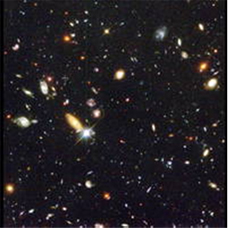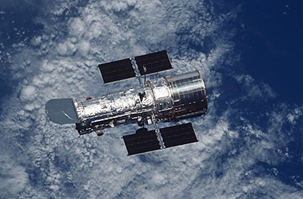
Source: The Universe: Hubble Deep Field,
Hubble Site

Source: The Universe: Hubble Deep Field,
Hubble Site
When asked the question "What is the universe?" what do you think of? Do you imagine the Earth? Or do you picture the Sun with planets orbiting around it? If so, you are only thinking of one small part of the vast structure that is our universe!
According the NASA’s StarChild Website, "The universe is a vast open space which contains all of the matter and energy in existence. The universe contains all of the galaxies, nebulae, stars, and planets. The exact size of the universe is unknown. Scientists believe the universe is still expanding outward. They believe this outward expansion is the result of a violent, powerful explosion that occurred about 13.7 billion years ago. This explosion is known as the Big Bang." The image to the right shows a portion of the universe as seen from the Hubble telescope. Almost every object in this image is a galaxy located anywhere from five to 10 billion light years away.
![]() Watch this short video to learn more about the universe.
Watch this short video to learn more about the universe.
Source: What is the Universe, RCO64, YouTube

Source:The Universe: Hubble Deep Field, Hubble Site
So how do we know about the size of the universe and structures found in it? Cosmology is the study of the origin and future of the universe. Data gathered by telescopes and satellites and computer models help cosmologists to study and understand the universe. The new discoveries help cosmologists not only understand our present day universe but also what the universe was like in the past and what it might be like in the future.
According to the Hubble website, "the Hubble Space Telescope was sent into space on the Space Shuttle Discovery on April 25, 1990; the telescope now orbits Earth. Its position above the atmosphere, which distorts and blocks the light that reaches Earth, gives it a view of the universe that typically far surpasses that of ground-based telescopes. Hubble is one of NASA's most successful and long-lasting science missions. It has sent hundreds of thousands of images back to Earth giving scientists insights on many of the great mysteries of the universe."
![]() To see some of the amazing images sent to Earth by the Hubble Space Telescope, watch this short video.
To see some of the amazing images sent to Earth by the Hubble Space Telescope, watch this short video.
Source: Hubble: Galaxies Across Space and Time, Hubble Space Telescope